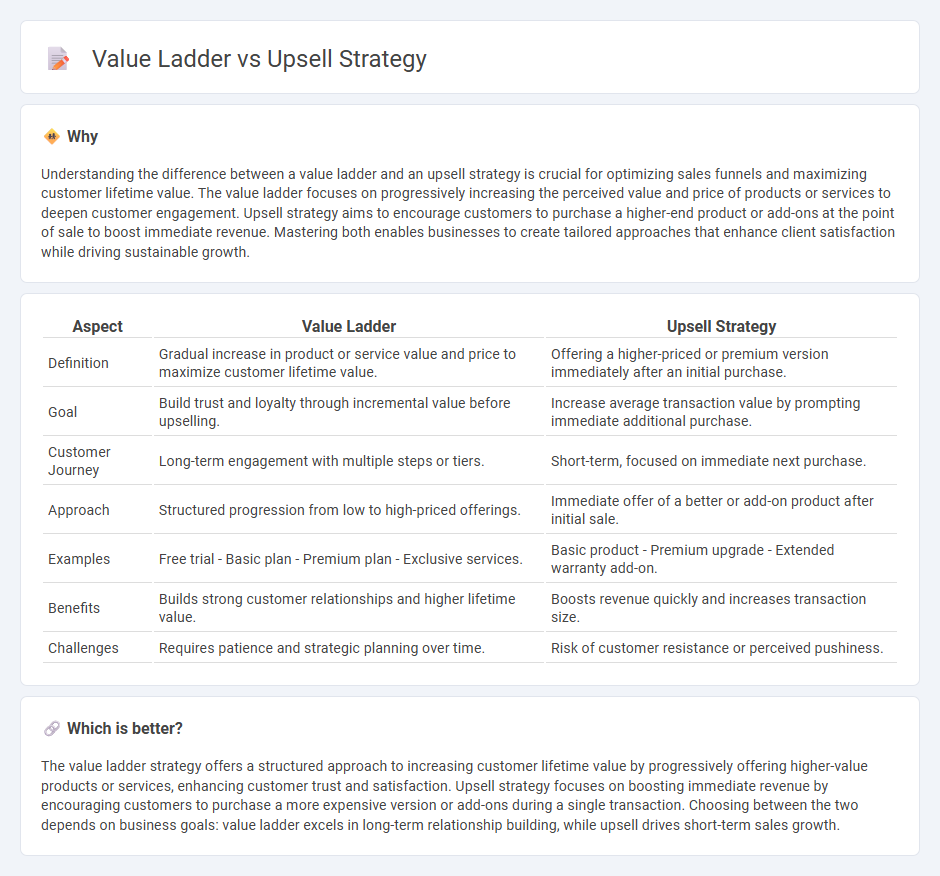
A value ladder strategy methodically increases customer commitment by offering progressively higher-value products, enhancing lifetime value through trust and satisfaction. Upsell strategy focuses on persuading customers to purchase a more expensive version of a product at the point of sale, maximizing immediate revenue. Explore the benefits and applications of each approach to optimize your sales performance.
Why it is important
Understanding the difference between a value ladder and an upsell strategy is crucial for optimizing sales funnels and maximizing customer lifetime value. The value ladder focuses on progressively increasing the perceived value and price of products or services to deepen customer engagement. Upsell strategy aims to encourage customers to purchase a higher-end product or add-ons at the point of sale to boost immediate revenue. Mastering both enables businesses to create tailored approaches that enhance client satisfaction while driving sustainable growth.
Comparison Table
| Aspect | Value Ladder | Upsell Strategy |
|---|---|---|
| Definition | Gradual increase in product or service value and price to maximize customer lifetime value. | Offering a higher-priced or premium version immediately after an initial purchase. |
| Goal | Build trust and loyalty through incremental value before upselling. | Increase average transaction value by prompting immediate additional purchase. |
| Customer Journey | Long-term engagement with multiple steps or tiers. | Short-term, focused on immediate next purchase. |
| Approach | Structured progression from low to high-priced offerings. | Immediate offer of a better or add-on product after initial sale. |
| Examples | Free trial - Basic plan - Premium plan - Exclusive services. | Basic product - Premium upgrade - Extended warranty add-on. |
| Benefits | Builds strong customer relationships and higher lifetime value. | Boosts revenue quickly and increases transaction size. |
| Challenges | Requires patience and strategic planning over time. | Risk of customer resistance or perceived pushiness. |
Which is better?
The value ladder strategy offers a structured approach to increasing customer lifetime value by progressively offering higher-value products or services, enhancing customer trust and satisfaction. Upsell strategy focuses on boosting immediate revenue by encouraging customers to purchase a more expensive version or add-ons during a single transaction. Choosing between the two depends on business goals: value ladder excels in long-term relationship building, while upsell drives short-term sales growth.
Connection
The value ladder and upsell strategy are interconnected by guiding customers through progressively higher-priced products or services that deliver increasing value. The value ladder builds trust and satisfaction at each step, creating opportunities for effective upselling by highlighting relevant upgrades or premium options. Implementing this approach enhances customer lifetime value and drives sustainable revenue growth.
Key Terms
**Upsell Strategy:**
An upsell strategy targets increasing the average transaction value by encouraging customers to purchase a higher-end product or add complementary items, thereby boosting revenue per sale. This approach often leverages customer data and personalized offers to present timely, relevant upgrades that enhance customer satisfaction and lifetime value. Explore detailed tactics and examples to maximize your upsell effectiveness and drive sustained business growth.
Average Order Value
An upsell strategy targets increasing the Average Order Value (AOV) by encouraging customers to purchase a higher-end product or add complementary items, boosting immediate revenue per transaction. The value ladder guides customers through progressively higher-value offerings, building trust and increasing lifetime customer value through a series of escalating purchases. Explore the distinct impacts of these approaches on your sales metrics to optimize business growth.
Cross-Sell
Upsell strategy emphasizes encouraging customers to purchase a higher-end product or premium version, increasing the average transaction value. The value ladder framework incorporates upsell and cross-sell techniques to progressively guide customers through multiple product tiers, enhancing lifetime customer value. Explore how integrating cross-sell opportunities within your upsell strategy can maximize revenue and deepen customer relationships.
Source and External Links
What is Upselling? 5 Upselling Techniques & Examples for 2025 - Uses urgency (like limited-time discounts) and social proof (reviews, testimonials) to encourage customers to upgrade their purchase for higher value and emotional appeal.
7 Key Components to Improving Upsell Strategy - Focuses on educating customers about relevant add-ons during the sales process and combines upsells with discounts to incentivize purchases.
How to Upsell: 11 Strategies to Boost Your Sales - Recommends offering relevant add-ons and upgrades, creating bundled packages, and using clear messaging to show the value of the upsell.
 dowidth.com
dowidth.com